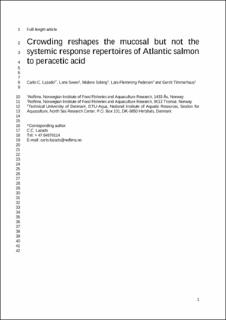Crowding reshapes the mucosal but not the systemic response repertoires of Atlantic salmon to peracetic acid
Peer reviewed, Journal article
Submitted version
Permanent lenke
https://hdl.handle.net/11250/2764278Utgivelsesdato
2021Metadata
Vis full innførselSamlinger
- Artikler / Articles [1456]
- Publikasjoner fra CRIStin [2533]
Sammendrag
Knowledge of the impact of aquaculture chemotherapeutants on fish physiology is scarce. This is particularly relevant for peracetic acid (PAA), a widely used oxidative disinfectant in aquaculture. The chemical behaviour in water is well studied but knowledge about the physiological consequences for fish is limited. The present study investigated the transcriptomics, morphology, and physiology of Atlantic salmon (Salmo salar) responses to PAA and explored how crowding prior to exposure influenced these responses. Post-smolts were subjected to crowding by reducing the water volume thereby increasing the density for 1 h before they were exposed to 4.8 ppm PAA for 30 min. The exposed fish were allowed to recover for 2 weeks (w), with samplings carried out at 4 h and 2 w post-exposure (p.e.). There were four treatment groups in total: no crowding/control; no crowding/PAA; crowding/control; and crowding/PAA. The physiological changes were documented at the mucosal (i.e., skin and gills) and systemic (i.e., plasma) levels. The overall external welfare score was in good status in all experimental groups. The treatments did not dramatically affect the number of mucous cells in both the skin and the gills. Branchial histomorphology was in a fairly good condition, despite the increased occurrence of epithelial lifting in the crowded groups at 2 w p.e. The gill transcriptome was affected by crowding, PAA, and their combinations more than the skin, as manifested by the number of differentially expressed genes (DEG) in the former. In general, individual stimuli and their combinations elicited strong transcriptional responses in the gills at 4 h p.e. and a marked recovery was observed 2 w thereafter. Crowding altered the dynamics of transcriptional response to PAA especially at 4 h p.e. and the two mucosal tissues demonstrated a contrasting profile – a higher number of DEGs in the gills without crowding history, while higher skin DEGs were observed in the group subjected to crowding prior to exposure. Plasma metabolomics identified 639 compounds, and the metabolomic changes were affected mainly by crowding and sampling time, and not by PAA exposure. The results revealed the ability of salmon to mobilise physiological countermeasures to PAA exposure that were differentially influenced by crowding, and that such an effect was remarkably exhibited at the mucosa rather than in the circulating metabolome.
